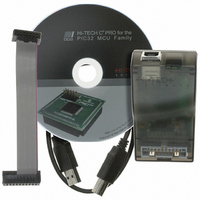SW500011 Microchip Technology, SW500011 Datasheet - Page 78

SW500011
Manufacturer Part Number
SW500011
Description
HI-TECH X PRO FOR PIC32
Manufacturer
Microchip Technology
Type
Compilerr
Series
PIC32r
Datasheet
1.SW500011.pdf
(440 pages)
Specifications of SW500011
No. Of User Licenses
1
Supported Families
PIC32
Core Architecture
PIC
Supported Hosts
Windows XP, Vista, Linux, Mac OS X
Software Edition
Professional
Kit Contents
Software And Docs
Tool Type
Compiler
Lead Free Status / RoHS Status
Not applicable / Not applicable
For Use With/related Products
PIC32 Series
Lead Free Status / Rohs Status
Lead free / RoHS Compliant
Other names
032
778-1007
778-1007
778-1007
778-1007
- Current page: 78 of 440
- Download datasheet (6Mb)
Supported Data Types and Variables
3.3.10.4 __strictcall Function Qualifier
If the __strictcall qualifier is used, only the first 4 a registers are used for passing parameters
to this function. If the __strictcall qualifier is not used, the HI-TECH C PRO for the PIC32
MCU Family will dynamically determine which registers to use for passing parameters for that
function.
3.3.10.5 ISA Function Qualifiers
Use of one of the mips16e or mips32r2 qualifiers may be used to explicitly generate a function in
the particular ISA. Note that these qualifiers will override the default ISA specified by the --ISA
option (see 2.6.32) for the qualified function. Note that interrupt functions can not be generated in
mips16e. If the default ISA is mips16e, ensure all interrupt functions are qualified as mips32r2.
3.3.11 Pointer Types
There are two basic pointer types supported by HI-TECH C PRO for the PIC32 MCU Family: data
pointers and function pointers. Data pointers hold the address of variables which can be read, and
possibly written, indirectly by the program. Function pointers hold the address of an executable
routine which can be called indirectly via the pointer. As the PIC32 has a flat memory space, both
of these pointer types are 32-bit and are addressed in the same manner. It is helpful to first review
the ANSI standard conventions for definitions of pointer types.
3.3.11.1 Pointers to Const
The const qualifier plays no direct part in specifying the pointer classification that the compiler will
allocate to a pointer. This qualifier should be used when the target, or targets, referenced by the
pointer should be read-only. The addresses of const objects assigned to a pointer will result in that
pointer having a classification capable of accessing the program space. The exact classification will
also depend on other factors.
this information to determine how large any pointers that can access const objects must be. Such
pointers are 4 bytes wide.
into the psect used to store the const data. For programs defining less than 64 kbytes of const
data, this data is placed into a psect called const; for larger const data amounts, the psect is called
constfar.
78
The code generator tracks the total size of const qualified variables that are defined. It uses
For pointer that are accessing const objects, the address contained within the pointer is an offset
Any hand-written assembler code, or C code that writes to the table pointer SFRs di-
C Language Features
Related parts for SW500011
Image
Part Number
Description
Manufacturer
Datasheet
Request
R

Part Number:
Description:
Manufacturer:
Microchip Technology Inc.
Datasheet:

Part Number:
Description:
Manufacturer:
Microchip Technology Inc.
Datasheet:

Part Number:
Description:
Manufacturer:
Microchip Technology Inc.
Datasheet:

Part Number:
Description:
Manufacturer:
Microchip Technology Inc.
Datasheet:

Part Number:
Description:
Manufacturer:
Microchip Technology Inc.
Datasheet:

Part Number:
Description:
Manufacturer:
Microchip Technology Inc.
Datasheet:

Part Number:
Description:
Manufacturer:
Microchip Technology Inc.
Datasheet:

Part Number:
Description:
Manufacturer:
Microchip Technology Inc.
Datasheet:










